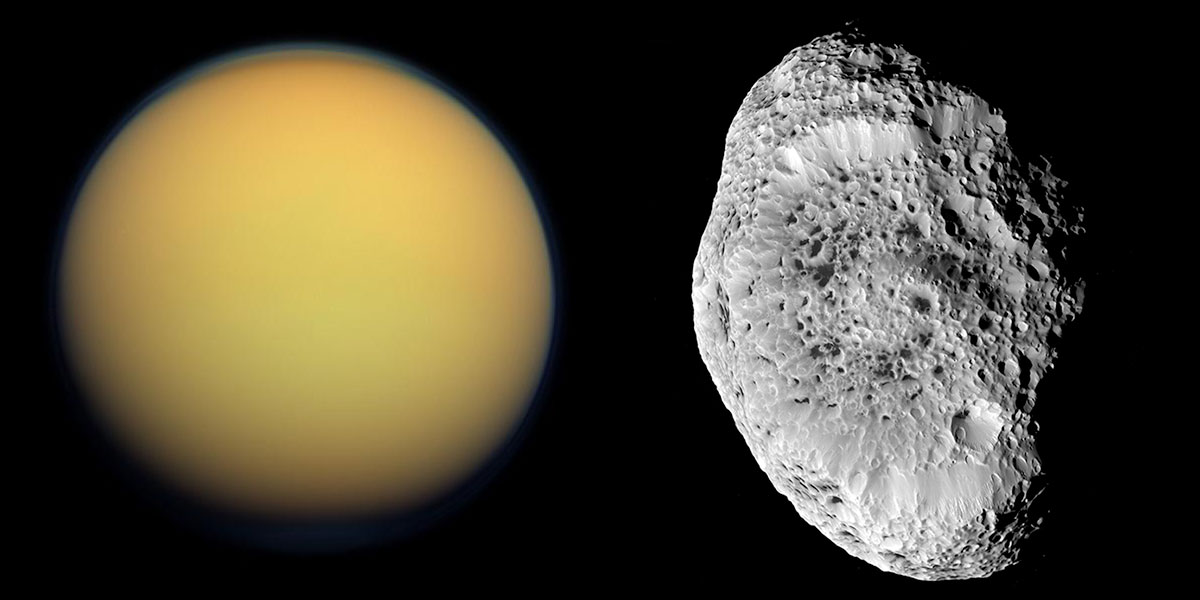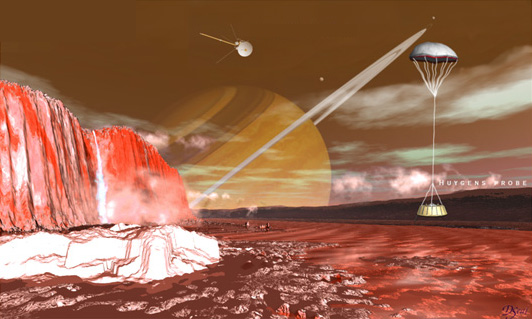One moon among many (for educators)
On this page
Young people (and older people!) are fascinated by the Moon, but they are sometimes unaware that there are many other moons in the solar system and beyond! These explanations will help reinforce a few concepts about moons that are sometimes misunderstood (!). We suggest a few things that may capture children's interest (magnifying glass icon) and provide answers to a few questions that children often ask (?). Canadian contributions to lunar research and exploration are also mentioned here and there (flag icon). Many other questions and answers can be found on the page for youth.
What is a moon?
A moon, or natural satellite, is a celestial body that orbits a planet or another small celestial body, like a dwarf planet or an asteroid.
!: exclamation point: to explain a few concepts about moons that are sometimes misunderstood: One challenge often encountered in the classroom is telling apart the different celestial bodies: star, planet, dwarf planet, asteroids, moon.
Stars produce their own energy, which is generated through nuclear fusion. Planets, dwarf planets and asteroids orbit around stars: none of these celestial bodies generate their own light.
Planets are larger than dwarf planets, which are larger than asteroids. What makes moons different is that they are not orbiting a star, but instead they are in orbit around a planet or another small celestial body.

There is often some confusion surrounding the different celestial bodies in the solar system. From left to right: our star, the Sun; the planet Mars; the dwarf planet Pluto; and the moon Pan, which orbits Saturn. (Credit: NASA)
! : exclamation point: to explain a few concepts about moons that are sometimes misunderstood: Given that the Moon is much smaller than our planet, Earth, it is easy to assume that every moon is smaller than every planet. However, that is not the case. The distinguishing factor between planets and moons is not their size.
Some moons are larger than planets (like Ganymede, one of Jupiter's moons, and Titan, one of Saturn's moons, both of which are larger than Mercury). Others are the same size as a city (like Deimos, one of Mars's moons, which has a diameter of approximately ten kilometres).

Moons come in a wide variety of shapes and sizes. Some of them are of a similar size to planets and spherical. This is the case for Titan (left), which is larger than Mercury. Others are more reminiscent of asteroids, both in shape and size, like Hyperion, one of Saturn's smaller moons. (Credit: NASA)
!: exclamation point: to explain a few concepts about moons that are sometimes misunderstood: Only large moons are spherical. Smaller moons have irregular shapes and are sometimes referred to as "potato-shaped
" because they look like... potatoes! It takes a minimum mass for a moon to take on a spherical shape under the effect of its own gravity.

Asteroid 243 Ida has a small moon, Dactyl. It is the first asteroid moon ever discovered (in with the space probe Galileo). (Credit: NASA/JPL)
Magnifying glass icon to suggest a few things that may capture children's interest: One thing that might capture children's interest is that we now know that dwarf planets have moons. Pluto has five, and we know that Haumea, Eris and Makemake have moons too. We also know that some asteroids have moons. These moons are very small, much like the celestial body they orbit. This is the case for Dactyl, measuring in at barely 1.5 km long. You could walk around it in an hour!

Artist's rendition of moons forming around a young planet. (Credit: Nagoya University/NAOJ)
? : question mark: to provide answers to a few questions that children often ask: One of the most frequently asked questions about moons in general is how they are formed. We believe that a few different mechanisms come into play during the formation of moons, which explains the great diversity in their features, like their appearance (e.g. shape, colour, presence of craters, volcanoes, canyons, geysers) and their movement (e.g. shape of their trajectory, direction, direction of rotation).
To answer this question, it might be helpful to first summarize the history of the solar system's formation. Approximately 4.5 billion years ago, a giant cloud of gas and dust collapsed on itself under the effect of gravity. This event created a star in the centre, the Sun, surrounded by a disk containing the remaining matter. That disk of debris is where the planets formed: small granules sticking together to form increasingly larger objects until they became planets. Some celestial bodies of varying sizes, like asteroids and comets, are not aggregated and continue to populate the solar system.
Moon formation
- It is believed that the planets were also surrounded by a disk of debris during their formation. Some moons were formed in these disks, in a similar way the planets were formed around the star. This is the case for Jupiter's large moons.
- On the other hand, some moons are comets or asteroids that were captured by the gravitational force of a planet when passing near it. This is the case for the vast majority of small moons.
- Other small moons may be the result of larger moons fragmenting.
- The Moon, which was formed by a giant impact between the young Earth and another small planet in formation, is therefore pretty unique compared to most of the moons in the solar system. We suspect that Charon, Pluto's largest moon, was also formed this way.
Moons in the solar system
The existence of a few hundred moons in our solar system has been confirmed!

A few moons in the solar system. From left to right: Tarqeq, one of Saturn's small moons that was discovered in ; Ganymede (Jupiter), the largest moon in the solar system; Deimos (Mars), one of the smallest moons in the solar system; Phobos (Mars), one of the moons that is closest to its planet; and Io (Jupiter), a moon covered in volcanoes. (Credit: NASA)
? : question mark: to provide answers to a few questions that children often ask: Children love learning about "records
" and other facts about the moons in the solar system. Here are a few questions that may interest them and show them that every moon is completely different, with its own well-defined properties.
- Which planets have the most moons? For now, Saturn has the most moons: it has 82. Jupiter has 79. This number may change again because we often discover small moons. This question is a good opportunity to point out that there are moons of every size and it is very difficult to find all of the small moons because they do not shine very brightly.
- Which planets do not have a moon? Mercury and Venus.
- Which is the biggest moon? Ganymede, one of Jupiter's moons, is the biggest. It is bigger than the planet Mercury.
- Which is the smallest moon? It is very difficult to say which moon is the smallest because it probably hasn't been discovered yet! Deimos, one of Mars's moons, is one of the smallest known moons. In general, dwarf planets, and especially asteroids, which are even smaller, have very small moons.
- Which moon orbits its planet the fastest? Some moons have very short orbital periods and orbit their planets in just a few hours. This is the case for Phobos, which takes less than 8 hours to revolve around Mars.
- Which moon has the most volcanoes? Io, one of Jupiter's moons, has approximately 400 volcanoes, of which approximately 150 are active.
- Which moons are the most promising in the search for extraterrestrial life? Europa (Jupiter), Enceladus (Saturn) and Titan (Saturn) are among the most frequently mentioned with regard to that subject (see below).

Titan

Enceladus

Hyperion

Mimas
Artist's representations of what could be found on the surface of a few moons in the solar system. : Titan, Enceladus, Hyperion and Mimas. (Credit: David Seal, NASA/JPL-Caltech)
Magnifying glass icon to suggest a few things that may capture children's interest: To captivate children's imagination, ask them to imagine they are on the moons in the solar system. What landscape would they see (surface, sky, view of the planet)? Artist's renditions are extremely useful for this exercise! How would they feel if there was an atmosphere? Or no atmosphere? If there is one, does its composition make a difference or not? How much would they weigh on this moon, and how high could they jump based on its gravity?
? : question mark: to provide answers to a few questions that children often ask: Children are interested in the names of the moons. Where do these names come from? Who names them? You can tell them that moons are generally named after gods and goddesses from different mythologies. For instance, a group of Saturn's small moons have names that come from Inuit mythology, such as Kiviuc, Ijirac, Paaliaq, Siarnaq and Tarqeq. To this day, we are still finding new moons and now, the public is often asked to help choose their names.
Exomoons

Artist's rendition of an exomoon orbiting a giant gaseous exoplanet. (Credits: NASA, ESA, and L. Hustak (STScI))
An exomoon, or extrasolar moon, is a moon that orbits an exoplanet, which is a planet located outside the solar system.
It is believed there are a few hundred billion stars in our galaxy alone, and that most of them contain planets. It is very likely that they have their own moons, exomoons.
Magnifying glass icon to suggest a few things that may capture children's interest: Show a photo of the starry sky and let the children imagine the planets and their moons surrounding each star.
Flag icon to point out Canadian contributions to lunar research and exploration: Research on exoplanets (and exomoons!) is very active in Canada. Many Canadian scientists are interested in these planets: they want to discover them and learn more about their various properties, and therefore better understand the history of our solar system and our planet. The James Webb Space Telescope, which will be launched in fall , will be very powerful and may detect the first exomoon. Canada contributed a scientific instrument and guidance sensor for this telescope.
? : question mark: to provide answers to a few questions that children often ask: Is there extraterrestrial life on moons and exomoons? It is easy to imagine that some exomoons are very similar to Earth and could therefore support life. However, these worlds are very far away and very difficult to detect. Truth be told, no exomoons have officially been discovered.
Exomoons are often represented in science-fiction stories. For instance, in the Avatar films, the story takes place on Pandora, an imaginary exomoon of the fictional planet Polyphemus in the system of one of Earth's nearest stars, Alpha Centauri A. Some moons in the solar system, including Enceladus and Europa, are promising in the search for extraterrestrial life because it is suspected they contain organic compounds and liquid water in the oceans beneath their surface.

Artist's representation of plumes of water vapour on Europa, one of Jupiter's moons. (Credit: Goddard Space Flight Center, NASA)
There are no moons or exomoons that could be used as "replacement planets
" where we could move in the short or medium term! They are very far away and, according to our current knowledge, very inhospitable for humans.
